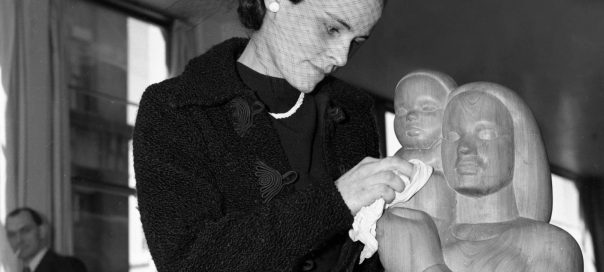
The first retrospective of Margel Hinder (1905–1995), one of Australia’s most important and dynamic, yet underrated, modernist sculptors will be presented at Heide Museum of Modern Art from 24 July to 17 October 2021. Margel Hinder: Modern in Motion will be displayed in the Heide’s main galleries and is a tribute to her great, and ever-expanding, creative vision. Developed in collaboration with the Art Gallery of New South Wales, the exhibition spans Hinder’s five-decade career and showcases approximately 70 sculptures sourced from private and public collections across Australia, as well as Art Gallery of NSW’s rich holdings of both her works and archive.
Margel Hinder: Modern in Motion aims to redress Hinder’s profile as one of the most underestimated Australian sculptors of the 20th century and uncovers the expansive nature of her creativity, and her skill in giving sculptural form to universal concepts like time and motion in materials expressive of the era. From her early carvings in wood and stone carvings in the 1930s and 40s, to the ‘space age’ kinetic and wire works of the 1950s and major public commissions in the 1960s, Margel Hinder: Modern in Motion traces the development of Hinder’s practice and her role in shaping modernist sculpture in Australia.
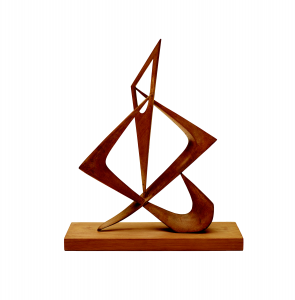
Heide Museum of Modern Art Artistic Director Lesley Harding said, “Apart from her inclusion in a few surveys of local modernism, Hinder’s vanguard practice and its legacy have largely been overlooked since the 1980s. This exhibition presents her innovative and visually arresting sculpture to new generations and the wide audience it deserves, highlighting her vital role in the making of Australian modernism and asserting the place of sculpture within it.”
Born in Brooklyn, New York, and educated in Buffalo and Boston, Hinder (nee Harris) migrated to Australia in 1934, following her marriage to Australian artist Frank Hinder, where her mature practice flourished. “After arriving in Sydney Margel quickly found a compatible and supportive milieu among artists similarly educated overseas and brimming with ideas, theories and methods that set them apart from their locally trained contemporaries. Over the ensuing years they made advancements in abstract art that paralleled those elsewhere in the world.”
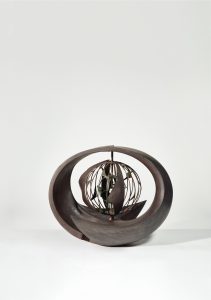
Added Harding who co-curated the exhibition with the Art Gallery of NSW Senior Curator of Australian art Denise Mimmocchi. Exhibition highlights include Hinder’s commanding kinetic works, whose slow rotations encapsulate a sense of the world in perpetual motion, and an immersive installation based on two of Hinder’s major public sculptures. Created by Dr Andrew Yip, Lecturer in Art & Design at the University of New South Wales, the life-size digital reconstructions are of two of the most significant public sculptures of Hinder’s career: the Civic Park Fountain, Newcastle 1961–66 and the now decommissioned Northpoint Fountain 1975.
This project allows for a presence of this important component of Hinder’s art within the context of her retrospective and demonstrates the sophistication of her ideas, with her inclusion of carefully choreographed moving water amid object formations. Mimmocchi said the exhibition is an opportunity to explore the breadth and depth of Hinder’s oeuvre.
“Margel Hinder: Modern in Motion brings together major sculptures from public and private collections, immersive representations of public sculptures, drawings and archival photographs to present an insightful portrait of the pioneering sculptor’s life and work. The Art Gallery of NSW has a substantial collection of more than 40 Hinder maquettes, recently restored for this exhibition, that reveal incredible details of her creative processes.”
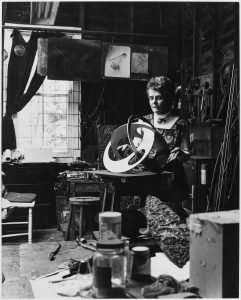
The exhibition is accompanied by the richly illustrated publication Margel Hinder: Modern in Motion featuring essays by Denise Mimmocchi; Lesley Harding; Art Gallery of NSW object conservator Melanie Barrett; Centre for Postdigital Cultures, Coventry University assistant professor of immersive media, Dr Andrew Yip; and a foreword by University of Oxford professor of the history of art Dr Geoffrey Batchen.
Margel Hinder: Modern in Motion – 24 July – 17 October 2021
Heide Museum of Modern Art – 7 Templestowe Road, Bulleen, Victoria
About Heide: Set on sixteen acres of parkland with Yarra River frontage, Heide Museum of Modern Art, or Heide as it is affectionately known, is one of Australia’s most important cultural institutions. Once a significant Wurundjeri gathering place, the property was later a dairy farm before becoming known as a hub for Australian modernist art and writing after it was purchased by art patrons John and Sunday Reed in 1934.
The Reeds opened their home to the most progressive artists of their era, including Sidney Nolan, Albert Tucker, Joy Hester, John Perceval, Charles Blackman and Danila Vassilieff. Nolan’s famous Ned Kelly series (1946–47) was painted in the dining room of the Heide farmhouse. Continuing this spirited legacy, today Heide works to inspire creative talent, collaborating with emerging and mid-career artists as well as celebrating those who have made major contributions to Australian and international art.





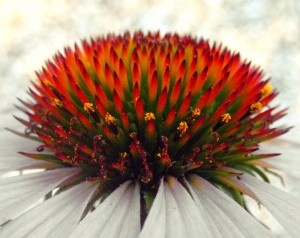
Get Social